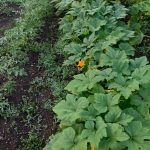Introduction
Shade covering can be an important tool for vegetable gardeners, especially those in climates where sunny days become overly hot. When temperatures skyrocket, plants try to escape the intense heat by curling their leaves and closing them. This prevents photosynthesis, resulting in slower growth, reduced production and nutrient deficiencies that can affect plants’ overall health. Shade cloth can solve these problems by shielding plants and soil from too much sunlight while still allowing a range of colors needed for photosynthesis and healthy growth.
Personal experiences from gardeners around the world highlight how shade covering has helped keep plants thriving even in hot climates. In Atlanta, one gardener built overhead trellises to protect his vegetables from direct sunlight during summer months, which enabled the garden to remain healthy and productive throughout the season. In Arizona, another gardener hung natural shade cloth made out of cotton fabric to keep her vegetables cool when temperatures soared into the triple digits. These case studies demonstrate just how essential shade covering can be when it comes to protecting vegetables from damaging temperatures that may otherwise stunt or wilt them over time.
Benefits of Shade Covering
Shade covering for a vegetable garden can provide numerous benefits. First, it can help reduce disease and insect problems by creating a barrier between the vegetables and environment. Shade cloths effectively block out some of the sun’s rays, reducing the temperature and decreasing the amount of moisture available to fungi and bacteria that cause diseases in plants. At the same time, they allow airflow through, so beneficial insects and pollinators can still enter the garden while other pests are blocked out.
In addition to reducing disease, shade covering can help protect against frost damage by providing insulation and moderating moisture levels in the air. This is especially important when temperatures drop suddenly at night or during colder weather. The coverings also act as wind breaks, protecting delicate or young plants from being damaged by strong gusts of wind.
Shade coverings are also beneficial because they absorb sunlight for increased productivity in a vegetable garden —this helps create an optimal growing environment for plants that produce best in cooler climates as opposed to extreme sunlight or heat. In addition to providing protection from sun-related damage, shade covering also helps create cooler patches where winter crops remain productive longer in otherwise too warm climates.
Types of Shade Covering
Tarp – Tarps are a great way to provide shade coverage for your vegetable garden. Typically made of plastic or canvas, they can be used to cover the entire garden or just a portion. Some tarps come with grommets in the corners which allows you to attach them to an A-frame or other structure.
Fabric – Fabric shade is another popular option for providing some protection for your plants from the sun. This type of shade covering comes in many different colors and patterns and can be installed with either a grommet system or tied onto a structure like an A-frame.
Plastic – Plastic is also a viable option for providing shade in the vegetable garden. Generally, it needs to be attached on one side only, since it’s not secure or supported by any structure. However, if properly affixed, it can provide decent protection from UV rays while still allowing sunlight into your garden.
Canopy Structures – Canopy structures are an excellent way to provide both partial and complete coverage when covering larger areas of your vegetable garden. These structures tend to be more expensive than simply using fabric or plastic but are often able to stand up against frequent wind and rain more successfully than their cheaper counterparts. They can be attached directly to the ground between two supportive poles and are designed in varying shapes and sizes according to your needs
Installation Process
Installation Guide for Shade Covering for Vegetable Garden
Materials Needed:
Shade cloth, a sturdy frame (e.g., metal or PVC pipe), scissors, a measuring tape and fastening material (e.g., tarp clips).
Tools Needed: Seam ripper, drill, hammer/mallet, pencil.
Step 1: Measure and Cut the Frame – Measure out the frame of the shade covering for your vegetable garden. It should be slightly larger than the space you’d like to cover in order to account for any excess when you install it on your vegetables. Cut the material for your frame with a scissors if necessary.
Step 2: Assemble your Frame– Using a drill, assemble your frame from whatever materials you chose in Step 1. Follow instructions provided by the manufacturer as appropriate; drilling in all designated spots then using a hammer/mallet to attach connectors as needed. If needed adjust with a mallet until everything is securely fitted together without gaps.
Step 3: Install Fasteners – Place fastening materials such as tarp clips wherever they are needed along the edges of your constructed frame. Make sure they are tight and secure so that it won’t shift during windy days but not so tight that it will cause damage when being taken down at harvest time. Use a drill if necessary to make pilot holes first before screwing in any screws or nails.
Step 4: Attach Shade Cloth – Unfold and place the fabric over your frame ensuring there is enough slack/room at ends so that you can properly secure it card with spacers later on down the line depending on what fabric you choose to use for covering (Eg – elastic cord, netting etc.). Attach each corner of shade cloth to secure edge clips drilled onto corners of metal frame from Step 3 using seam ripper or pins as desired OR alternatively just secure corners manually with elastic cord around entire perimeter of metal frame along documented spots if possible. Note – check periodically during season growth to ensure shade cloth remains taught but not too tight across surface of ground which may lead to ripping where clamps were secured due to weight applied below during growing seasons and rainy weather conditions etc…
Step 5: Finalize Setup – If using an elastic cord – stretch Elastic Cord above horizontal fasteners as previously mentioned then proceed around loosely looping it above horizontal fasteners while placing corresponding spacers next few meters greater apart in between connecting points made above continuous looping course sections all way around circumference (successive metallic structure). This will further reinforce-stabilize entire project forming permanent “shade hut” effect during sunny days protecting plants below from scorching heat reservoirs increasing longevity significantly..
Maintenance Tips
1. Cleaning – Regularly inspecting and cleaning your shade covering will help ensure it does its job of protecting your vegetable garden. To clean, use a brush to wipe away any dirt or debris, then spray down the fabric with a hose and mild soap solution.
2. Securing – The wind can be quite powerful and can cause unexpected damage to your shade covering if not properly secured. Make sure you’ve tightly secured the edges of your shade covering near the ground and have added weight, such as rocks or sandbags, to keep it in place during windy days.
3. Storing When Not In Use – Shade coverings are sturdier when they’re tightly packed and stored in a cool, dry place away from direct sunlight when not in use, such as in a garage or shed. Carefully fold the fabric before storing it to avoid causing any scratches or tears while handling it.
4. Repairing – If you notice any wear or damage to your shade covering over time, first identify the issue and then decide whether or not you want to repair it yourself or seek professional help. You can make small repairs by using an iron-on patch if you don’t want to purchase an entire new piece of fabric.
Other Shade Options
Umbrellas are a great option for shade in vegetable gardens. They provide up to 5 feet of shade and come in a variety of colors, shapes, and sizes. These umbrellas can be easily set up by a single person and moved around with ease to provide the desired coverage for your garden.
Shade sails are another popular choice for shading vegetable gardens. These are often seen in backyards, providing even more coverage than umbrellas due to the material used. Shade sails typically have triangular panels that can be adjusted and angled to capture the most sunlight while creating a shady spot underneath. These sails come in different shapes and sizes as well to fit any size garden or area.
Conclusion
Shade covering is an important component of any vegetable garden. It helps regulate the temperature and reduce heat exposure, as well as keeps out damaging pests. Properly constructed shade coverings will last far longer, look better, and offer greater protection than others that are not constructed correctly. To maintain the highest level of shade protection, it is recommended to regularly inspect the coverage to make sure that it remains secure, in good condition, and free from damage from animals or other external sources. Homeowners should also take measures such as adding sun shields or window awnings for shadier areas with more exposure. In addition, routine maintenance and investigations are necessary for successful shade covering for vegetable gardens in order to ensure optimal results throughout their life span. With proper construction and care, shade covering can help provide a cleaner environment for vegetables to grow in and protect them from extreme weather conditions.

If you’re looking to get into vegetable gardening, or are just looking for some tips on how to make your current garden better, then you’ve come to the right place! My name is Ethel and I have been gardening for years. In this blog, I’m going to share with you some of my best tips on how to create a successful vegetable garden.





